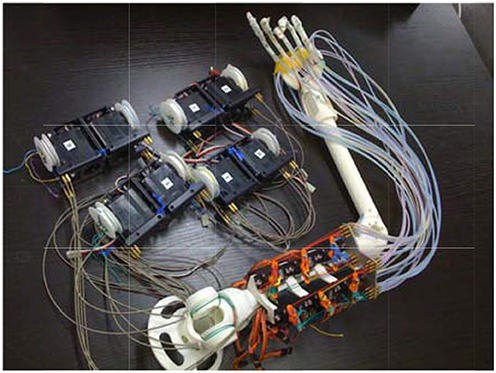Proprioception: Balance and Phantom Limbs
25 Active Prosthetic Limbs
Learning Objectives
Be able to explain what targeted muscle innervation is, and why it is done.
Be able to describe at least 2 ways that people build Brain/Machine Interfaces.
Prosthetic limbs have been around for a long time, and mechanical improvements are continuously being made. Active prosthetic limbs are exciting, although they are difficult to control without sensory feedback. First we will talk about two approaches for controlling active prosthetic limbs (since directly wiring into the nervous system isn’t an option due to reasons of complexity, vulnerability, and stability).
The first approach, targeted muscle reinnervation, provides control signals once patients relearn how their stump muscles map to bionic limb parts. In targeted muscle innervation, a physician surgically reroutes a motor nerve so the neurons grow out and innervate a muscle, creating little twitches that sensors can pick up. The sensors then decode the user’s desired action from the pattern of twitches in the reinnervated muscle. In simpler terms, targeted muscle reinnervation gives severed nerves something to do and somewhere to go.

The second approach for controlling active prosthetic limbs is called Brain-Machine Interface. When direct access to peripheral nerves is not an option, electrophysiological signals from the brain can be used to control the bionic limbs. These signals can be detected either invasively or non-invasively. Invasive approaches allow for higher success in prosthetic limb control, but the degeneration and necrosis limit the long-term use. This obstacle led researchers to develop non-invasive methods, such as electroencephalography (EEG) electrodes. EEG electrodes are placed on the scalp. The electrodes record the brain signals and are sent to a computer that determines what motion the user wants to accomplish. Another way to build a Brain-Machine Interface for prosthetic limbs are electrocorticography (ECoG) electrodes, which is an invasive signal detection method involving the use of a surface electrode on the cerebral cortex under the dura mater. It is important to note that this approach has long-term stability with low clinical risk.
CC LICENSED CONTENT, SHARED PREVIOUSLY
Cheryl Olman PSY 3031 Detailed Outline
Provided by: University of Minnesota
Download for free at http://vision.psych.umn.edu/users/caolman/courses/PSY3031/
License of original source: CC Attribution 4.0
Adapted by: Ryleigh Orning
Brain-machine interface to control a prosthetic arm with monkey ECoGs during periodic movements.
Authored by: Morishita S, Sato K, Watanabe H, Nishimura Y, Isa T, Kato R, Nakamura T and Yokoi H
Provided by: Frontiers in Neuroscience
Url: https://doi/org/ 10.3389/fnins.2014.00417
License: CC BY 4.0
Adapted by: Sayla Hendry
References:
Lebedev, M. A. & Nicolelis, M. A. L. (2006). Brain–machine interfaces: past, present and future. TRENDS in Neurosciences, 29(9):536.

